2010 Chevrolet Corvette ZR1 vs. 2010 Porsche 911 Turbo
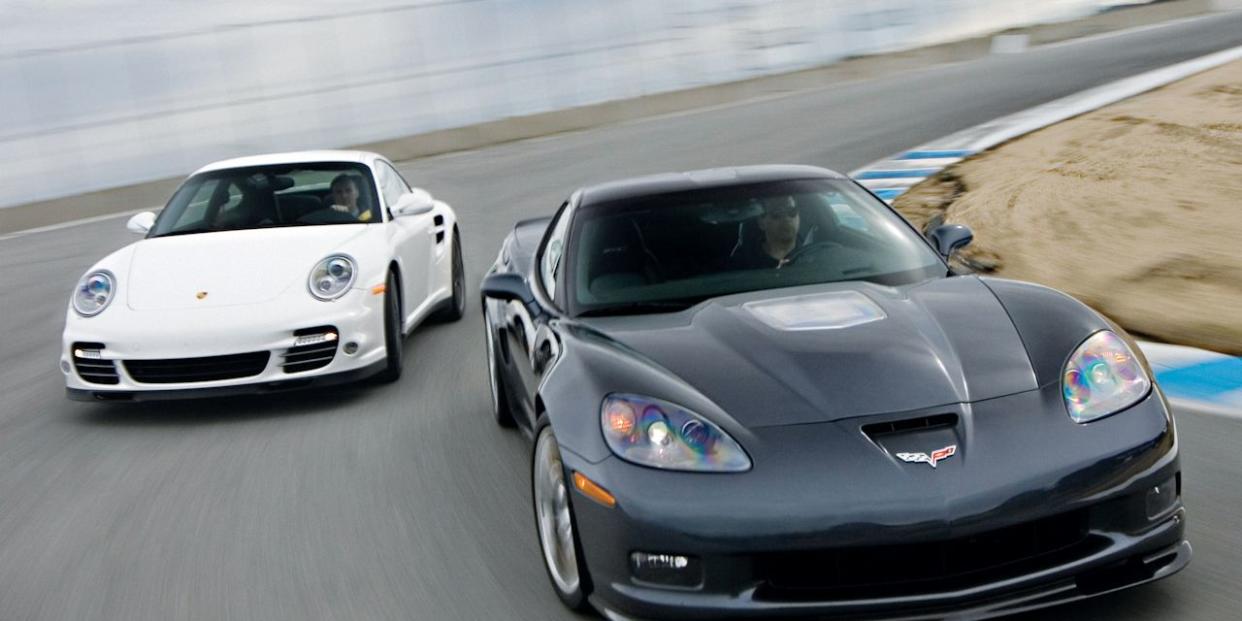

Ever since the 911 hit U.S. showrooms in 1965, the Chevrolet Corvette and Porsche’s most iconic car have been facing off on racetracks and canyon roads all over the world. And through the years, the cars have displayed immensely diverse characteristics: The American is straightforward yet effective and entertaining; the German is slightly strange yet undeniably sophisticated.
The layout of each car has hardly changed since inception. A 1965 Corvette used a fiberglass body and a transverse leaf spring out back. It looked cool but was a little low-rent inside, had a monster V-8 up front driving the rear wheels, and seated just two. It’s the same with today’s sixth-generation Corvette.
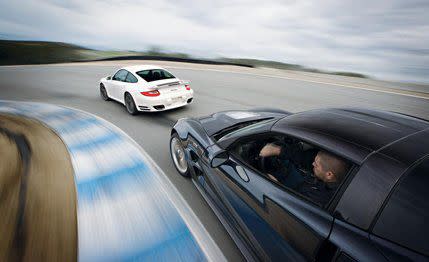
The output of that original Porsche 911—148 horsepower from 2.0 liters—was a bit wimpy compared with that of today’s car (345 horses, 3.6 liters), but the horizontally opposed six still hung out behind the rear axle. The 911 has always had room for two full-size people up front and a couple of miniature versions behind them, as well as a decent front trunk. And even those who could not care less about cars can see the family resemblance between that first 911 and its modern counterpart.
The first 911 with a turbocharger appeared stateside in 1976, powered by a 3.0-liter flat-six that made a relatively modest 247 horsepower and gave rise to the term “turbo lag.” A combination of light-switch throttle response and scary lift-throttle oversteer, courtesy of the car’s semi-trailing-arm rear suspension and all that weight out back, resulted in a car that intimidated even the bravest drivers on a wet road. Still, that first 911 Turbo was regarded as an out-and-out supercar, a reputation it has held for the 34 intervening years.
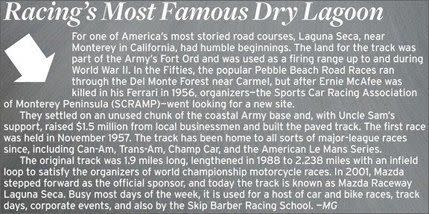
That couldn’t quite be said of the Corvette. Back in the early days of this rivalry, a Corvette would dole out a straight-line ass whupping to any 911, but by the time the Turbo arrived on the scene, the Corvette had been reduced to an emissions-emasculated shadow of its former self. Between the dawn of the 911 Turbo and the arrival of the 2001 Z06, the only Corvette that could be compared with the Turbo was the Lotus-engineered ZR1 of 1990 to 1995.
The Z06, based on the fifth-generation Corvette architecture, brought the car back into the supercar realm. The subsequent sixth-gen car was good enough to come in a close third to a second-place 911 Turbo in a three-car comparo in Germany [“The Sports-Car World Cup,” September 2006], won by the Ferrari F430. So we eagerly anticipated putting the even faster, more refined, and markedly more expensive Corvette ZR1 up against a 911 Turbo in early 2009. But when that time came, Porsche mysteriously couldn’t find a car to make available to us for a comparison with a ZR1, a Lamborghini Murciélago, a Dodge Viper SRT10, and a Mercedes SL65 AMG Black Series [“Unnatural Selection,” March 2009]. The ZR1 won, and Porsche no doubt heard that the victory put Mercedes-Benz’s aristocratic schnoz out of joint.
Since then, the Turbo, along with the rest of the 911 range that’s based on the 997 architecture introduced in model year 2005, has been revised. This time, Porsche found us a Turbo, which we picked up in Los Angeles. Then, keys to a ZR1 in hand, we headed off to the great driving roads of central California and later to the Mazda Raceway Laguna Seca track.

From the C/D Archives: 1991 Chevrolet Corvette ZR-1 vs. 1991 Porsche 911 Turbo (April 1991)
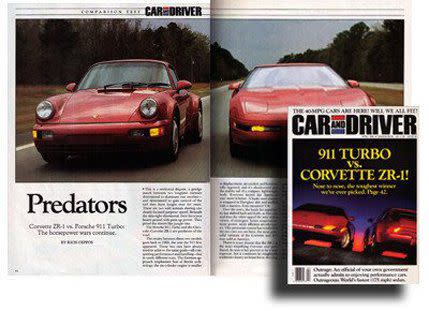
The Chevrolet Corvette and the Porsche 911 have one of the greatest long-standing rivalries in the automotive universe. With a heavily reworked 911 Turbo arriving for 2010, we couldn’t help but line it up next to the awesome, 638-hp Corvette ZR1 for another Detroit-versus-Stuttgart showdown. You can read all about it here, where you’ll see that the results have changed significantly from when these two icons first squared off in 1991. Back then, the Turbo was rear-wheel-drive only and produced just 315 hp from an air-cooled 3.3-liter flat-six with a single turbocharger. The first-generation ZR-1—which was built on the fourth-gen Corvette platform—by comparison, packed a high-tech, 5.7-liter DOHC V-8 that made 375 hp. The ZR1 still holds the horsepower advantage, but the Porsche continues to prove that there’s more to it than that.
More archive stories are available here.

This ultimate Corvette hides its bulging muscles under a relatively discreet set of duds. Only rabid Corvette geeks can tell at a glance; ZR1 clues involve its carbon-fiber roof, chin spoiler, and hood with a see-through panel. Look closer, and you’ll see that forged aluminum wheels cover giant Brembo carbon-ceramic brakes that are 15.5 inches in diameter at the front axle, 15.0 inches in the back. Inside, the ZR1 has some subtle changes, but the overall ambience continues the low-rent tradition, especially compared with the dressy Porsche—certainly not what you’d expect in a sports car that stickers for $121,425.
Still, the big price buys a lot of performance equipment. The 638-hp, 6.2-liter supercharged V-8 LS9 engine features such niceties as titanium connecting rods and intake valves, a forged steel crankshaft, and a dry-sump oil system. The suspension has magnetorheological shocks that enabled Chevrolet engineers to use softer springs than in the conventionally damped Z06.
On narrow mountain roads, the Vette seems huge, although it doesn’t feel all that big inside. The rear hatch, however, opens to an impressively sized luggage area. The minor controls may not look fabulous, but the ventilation, sound, and navigation systems are very intuitive, and the driving position and control layout are good. The seats suck, though: They don’t have enough lateral support, and the backs flop around under hard acceleration and braking. It’s details like this that make you realize that the base Corvette is built to a price (roughly $50,000), whereas the $158,085 911 Turbo is based on a car that starts at about $80,000.
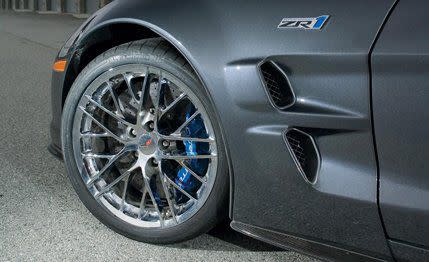
Trolling highways at 80 mph or so, the ZR1 is surprisingly civilized, providing a supple ride with the adjustable shocks in “tour” mode. Wind, tire, and engine noise seems remarkably subdued at cruising speeds despite higher sound-level measurements than in the Porsche. In fact, the car’s a bit disappointing in this environment unless the driver downshifts a couple of gears and floors the throttle, at which point the car simply disappears into the horizon, its V-8 emitting a strident growl.
When the ZR1 gets driven really hard, it livens up like a nerdy college kid who discovers beer and girls on spring break in Mexico. The engine note is a constant delight under heavy throttle, as is the way the car shortens the distance between corners. The steering, which is inert on-center, becomes livelier with cornering g-forces, and the Brembo brakes are sensational, even if the pedal is a bit soft. The shifter isn’t the most willing on earth, but the engine has so much torque spread over so wide a band that shifting becomes almost superfluous.
On a bumpy back road, the Corvette is a bit spooky at first because the giant tires follow road contours a bit too closely and the horrendous horsepower overwhelms the best efforts of the stability system to keep the back end in check. It’s possible to generate quite a lot of slip angle with the stability system engaged unless one sets it to a new wet-weather program that was introduced for 2010. In that instance, the system cuts power more quickly, in addition to applying the brakes, and the rear end steadfastly refuses to slide. It’s odd to hear the engine misfiring as the throttle is mashed, but it’s reassuring, too: With the system completely switched off, it’s as easy to spin this thing in the wet as it is to lose self-control at an all-you-can-eat buffet.
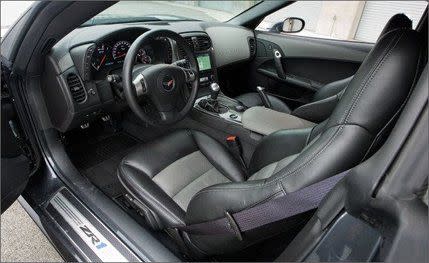
The Corvette moves around a lot more than the 911. It dives more under braking, squats more under hard acceleration, and rolls more before it calms down in midcorner, even with the shocks switched to “sport.” Aside from that, it’s blindingly fast over any stretch of blacktop and is a mighty track weapon. On a cold day, the Vette lapped Mazda Raceway a full second faster than the 911. Down the front straightaway, our VBOX test gear recorded 130 mph for the Vette just after it crested a brow, where it went light and a touch sideways before settling down on the other side.
The ZR1 is still one of the most entertaining cars ever built. It’s not for the faint of heart, but it’s a visceral thrill that’s worth setting every nerve in your body on edge. The car’s a little rough around the edges but warmhearted underneath. It just wants you to have a good time, and it certainly delivers when you’re in the mood. We’re just glad that, in these perilous times, GM continues to make this car.

The Corvette was looking good. It was faster around Laguna Seca. It won the battle for grip on the skidpad (although the roadholding performance of both cars suffered due to unfavorable track conditions). It stopped more dramatically. It’s cheaper than the German. But it’s not as quick in a straight line—and that was a shock.
The Turbo whistled from 0 to 60 mph in 2.9 seconds and from 0 to 100 in 6.8, 0.5 second and 0.8 second faster than the ZR1, respectively. At the finish of a quarter-mile, the ZR1’s 128-mph trap speed was as good, but the Porsche got there 0.5 second quicker, at 11.0 seconds. Technical editor Aaron Robinson was wide-eyed over the way the Turbo launched, and he normally reserves that kind of reaction for rockets at Cape Canaveral.
The 911 Turbo simply got a whole lot better for 2010. Porsche started with the engine. The displacement is up from 3.6 to 3.8 liters, direct injection has been added, and changes were made to the turbocharging and exhaust systems. The result is 500 horsepower instead of 480 and 479 pound-feet of torque, up from 460. The $3830 Sport Chrono package, with which our car was fitted, has an overboost function that bumps boost from 11.6 psi to 14.5 psi and produces an additional 37 pound-feet (516 total) for up to 10 seconds at a time.
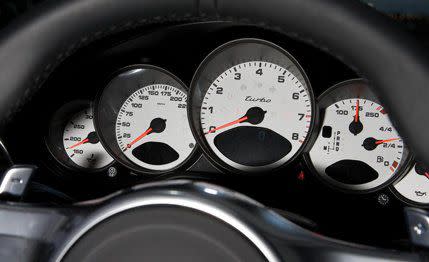
Also new to the Turbo is a beefed-up version of Porsche’s twin-clutch PDK transmission (a $4550 option). It replaces the old Tiptronic five-speed torque-converter automatic and is available for the first time with dedicated paddle shifters (an additional $490). The revised BorgWarner all-wheel-drive system now allows more rear-tire slip before appropriating additional torque to the front axle, to give it more of a rear-drive feel. To address complaints about too much understeer, Porsche fitted stiffer front and softer rear anti-roll bars, firmer and variable-rate rear springs, and recalibrated adjustable shocks. Plus, in an attempt to mimic a torque-vectoring rear differential, Porsche offers a $1320 option that gently brakes the inside rear wheel to reduce understeer: This insinuation phases out gradually above 75 mph and disappears altogether above 100 mph.
With all its dramatic strakes and scoops and beautiful 19-inch wheels, the Turbo looks like a 911 but with more malevolence. Inside, our test car came with the full catalog of Porsche options, even bright-yellow seatbelts ($540!) that raise the issue of taste in an otherwise supremely classy cabin.
Compared with the Vette, the Porsche feels more compact and wieldy even before the flat-six engine is cranked alive. The relationship between the seat and the steering wheel is exemplary. The car is also very practical for such a high performer, with a limited front trunk and more luggage space if the rear “seats” are folded down to form a shelf.
On the highway, the Turbo rides more stiffly than the Corvette, and its tires slap more over chewed-up pavement, but it’s never uncomfortable. Putting the adjustable shocks in their “sport” setting is advisable only on a track, though, because it will rattle fillings loose on lousy pavement and buck the car off line over bumpy back roads.
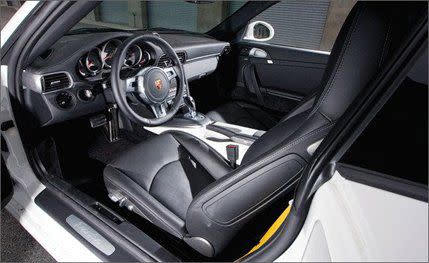
Across country, the Turbo is, in the words of Robinson, “the android-controlled technobomb compared with the street-punk ZR1.” The ease with which it’s guided at intergalactic speeds is just amazing. It turns into corners with alacrity and exits with the unruffled traction of all-wheel drive. The steering is weighted wonderfully and connected securely to the blacktop. The brake pedal offers otherworldly feedback, and the aluminum paddles click off shifts with a sniper’s precision. The car is super-stable at jailbait speeds, and it covers most roads with the kind of fluency the Corvette can’t match.
Our only slight disappointment involves the engine. The power band feels much narrower than the Vette’s fat torque curve and the engine doesn’t sound as good, either, with a muted wail under hard acceleration that’s masked by turbo whoosh. A naturally aspirated 911 sounds far better.
At Mazda Raceway, the 911 Turbo wasn’t as fast as the Vette, but it was much easier to drive hard. For most drivers, the greater tactility of the 911 makes it more enjoyable because you don’t need to be on the ragged edge to get gobs of feedback and driver involvement. At the limit, though, with the stability control off, a driver has to be judicious with the throttle because a big lift off the power can cause the rear end to swing wide. Keep the system engaged, however, and it’s remarkably benign, even in the wet.
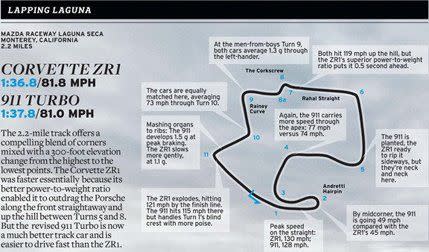
In the end, we say the Porsche is the better all-around car, showing the results of 34 years of uninterrupted honing and refinement, whereas the Corvette has finally begun to catch up after some years of neglect. The Vette also feels much cheaper than the $37K price disparity suggests. The fact that it came in second in this two-car fight may be irrelevant to some because we don’t expect a Corvette ZR1 buyer to turn up at a Porsche showroom anytime soon, or vice versa. As different in character as their would-be owners, these lifelong rivals have never been more competitive.
You Might Also Like

